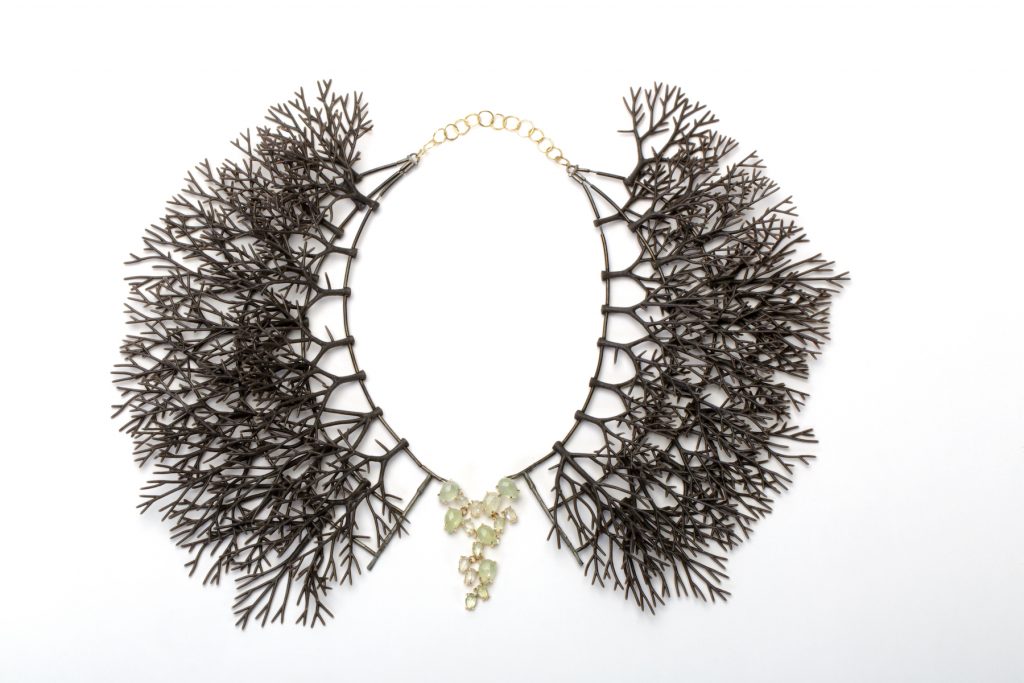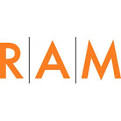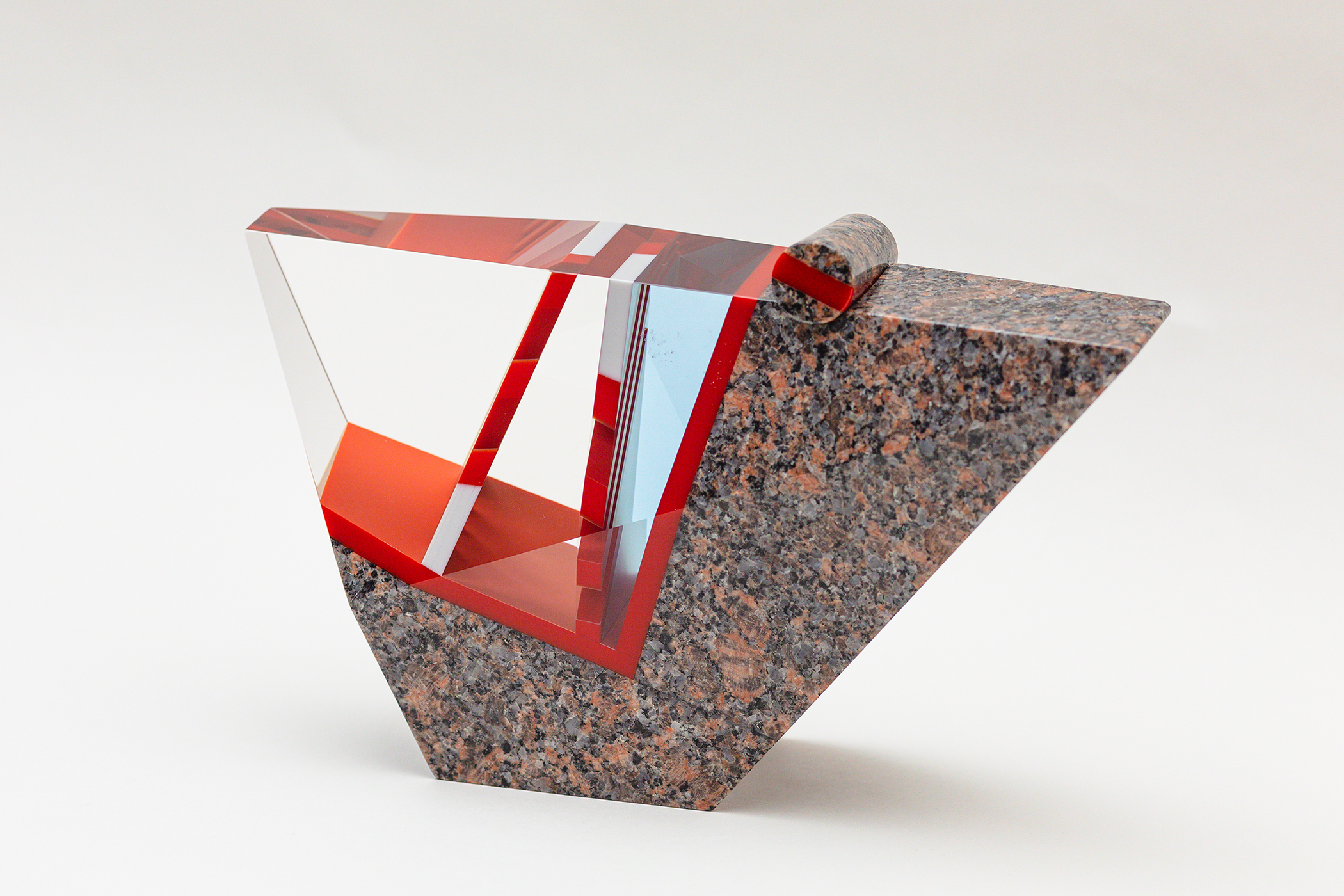A new exhibition showcasing jewelry made from non-precious materials opens at Racine Art Museum

Sarah Hood. Tree Collar #2, 2011. Sterling silver, 14k-gold, 18k-gold, prehnite, and plastic. 11 1/4 x 13 1/4 x 1 1/2 inches. Racine Art Museum, RAMA Purchase. Photography: Jon Bolton
Racine, WI October 17, 2024
A new exhibition that draws from the museum’s permanent collection and focuses on jewelry made from non-precious materials opens on Wednesday, October 30, at the Racine Art Museum (RAM). Featuring art jewelry made from repurposed materials originally intended for a use other than adornment, Zero Waste: Jewelry challenges viewers’ notion of what jewelry is.
Found items from the natural world, including bone, twigs, shells, and fibers, have often been utilized throughout the history of jewelry to create wearable pieces. While Western jewelry historically had a popular association with precious metals and gemstones—excepting, perhaps, less expensive fashion jewelry—many contemporary art jewelers have found interest in and formed a practice incorporating non-precious materials into their work.
“However,” as RAM Director of Exhibitions Lena Vigna notes, “most jewelers represented at the museum are trained metalsmiths with backgrounds in manipulating jewelry materials that are considered more traditional, such as gold and silver. Whether or not the artists utilize these materials in their work, they have the knowledge to work with a broad range of media and processes. That so many choose to use found objects reflects a self-conscious nature in their practice and a desire to create work that speaks to wearers and viewers in profound ways.”
In the world of art jewelry, the idea of using found objects received renewed attention in the latter half of the twentieth century when many artists adopted non-precious materials—such as plastic, paper, fabric, and found objects—for use in their work. While mass-produced modern costume and fashion jewelry made with cheaper materials has become popular, the one-of-a-kind, expensive jewelry prominent in Western cultures is still associated with status and display. Interested in investigating new roles for jewelry and challenging some assumptions, artists found ways to incorporate non-precious materials into their practice as they subverted ideas of wealth and suggested new meanings for adornment.
Vigna enjoys displaying artwork made from materials that some might consider unusual, and believes that RAM is the perfect museum to do so thanks to its focus on craft.
“Many associate the word ‘craft’ with certain kinds of materials. Craft can also describe processes and techniques. RAM has numerous works that draw on craft history while incorporating found objects—from nature or mass-produced in some way. These works can make an immediate connection with viewers as they realize they are viewing something they did not expect to see in an art museum, such as candy and zippers. As the range of works in RAM’s collection illustrates, artists have long been interested in repurposing materials. The unexpected use of certain media—and the ability to connect to visitors on another level—adds further importance to the critical issues regarding sustainability and excess.”
Zero Waste: Jewelry is on display through February 22, 2025. Further information about this exhibition can be found on RAM’s website, ramart.org.
Exhibitions at Racine Art Museum are made possible by: Platinum Sponsors—The Estate of Karen Johnson Boyd, David Charak, Judith and David Flegel Fund, Ron and Judith Isaacs, Racine Community Foundation, United Way of Racine County, Barbara Waldman, Windgate Foundation,; Diamond Sponsors—Ruffo Family Foundation, Ruth Foundation for the Arts; Gold Sponsors—Anonymous, Osborne and Scekic Family Foundation, Trio Foundation of St. Louis, W.T. Walker Group, Inc., Wisconsin Arts Board; Silver Sponsors—Anonymous, Baird, Ben and Dawn Flegel, Friends of Fiber Art, International, Sharon and Tom Harty, Dave and Judy Hecker, Horizon Retail Construction, Inc., Johnson Financial Group, Lang Family Foundation, Dorothy MacVicar, Jan Serr & John Shannon; Bronze Sponsors—Dave’s Wine Garage, Educators Credit Union, Express Employment Professionals, Lucy G. Feller, Hitter’s Baseball, SC Johnson, Bill and Debbie Keland, Nancy and Nick Kurten, Susan Manalli, Norbell Foundation, JoAnna Poehlman, Rasmussen Diamonds, Titos, Twin Disc; Media Sponsor—Radio Milwaukee
NOTE: This press release was submitted to Urban Milwaukee and was not written by an Urban Milwaukee writer. While it is believed to be reliable, Urban Milwaukee does not guarantee its accuracy or completeness.























